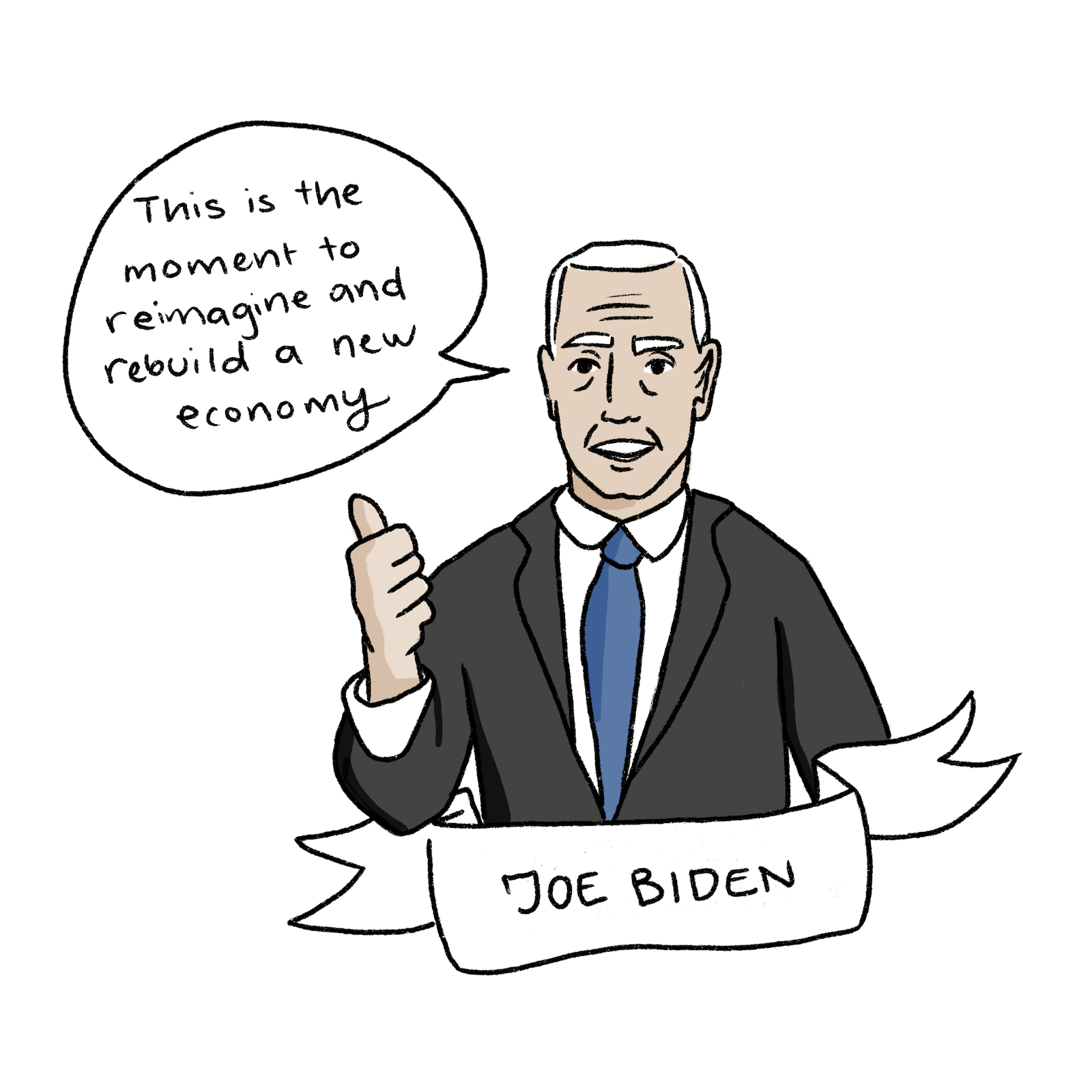This story is part of Grist’s 2021 Comic Recap — an illustrated look back on some of the year’s biggest climate stories. To read the other installments, click here and here.
If you’ve been attempting to keep up with the status of President Biden’s big climate plans in 2021, you’re probably feeling pretty exhausted by now. Democrats’ ambitious policy proposals have undergone more twists and turns than a Netflix true-crime drama — with plenty of scars to show for it. Now, it seems one of the biggest pieces of legislation, the Build Back Better Act, has been shelved for the foreseeable future. So wait, how did we get here again? Read on for a look back at some of the biggest climate policy moments from 2021.
Way back in March 2021, President Biden unveiled a $2 trillion dollar infrastructure bill called The American Jobs Plan. Its goals? To spur economic recovery from the pandemic, address the nation’s ailing infrastructure, create jobs, and tackle climate change — all at the same time.

The climate centerpiece of the original Biden plan was something called a clean electricity standard. The standard would have required utilities to produce 80 percent clean electricity by 2030 — a key part of Biden’s promise to slash overall emissions by 50 percent.

The first obstacle the bills had to face: the filibuster and Senate Republicans.
Republicans wouldn’t vote for a clean electricity standard, and Democrats only hold a razor-thin 51-vote majority in the Senate, with Vice President Kamala Harris serving as the tie-breaker. That’s too narrow to defeat the filibuster, a rule that allows the minority party to block almost any bill with less than 60 votes.

To circumvent the filibuster, the White House decided to split the original $2 trillion dollar plan into two bills. The first, an infrastructure bill, contained funding for roads, bridges, and other infrastructure — and it cut out most climate provisions to win Republican support. The rest of Biden’s climate agenda — half a trillion dollars in funding to address the causes and impacts of climate change — went into a “human infrastructure” bill called the Build Back Better Act.

The infrastructure bill — now stripped of major climate policies — passed the House on November 5, 2021 and was signed into law by Biden a week later.

Democrats then turned their attention to the Build Back Better Act, which they planned to pass via an arcane Senate maneuver called budget reconciliation. The reconciliation process allows the majority party to pass legislation that deals with spending, taxes, or the debt limit with only 51 votes, effectively bypassing the Senate filibuster rule.

To fit the reconciliation rules, Biden’s clean electricity standard needed to be modified. Members of the Senate, with help from environmental nonprofits, transformed the clean energy standard into the Clean Electricity Performance Program, or CEPP, which tried to achieve the same goals by penalizing utilities for using fossil fuels and rewarding them for using clean energy.
But even this adapted version hit a wall when Senator Joe Manchin — a Virginia Democrat with deep ties to the fossil fuel industry — refused to vote for it. As a result, the CEPP was eliminated and Democrats went back to the drawing board.

Build Back Better still contained $555 billion in climate spending — including clean energy and electric vehicle tax credits, incentives to capture CO2, and much, much more. Analyses showed that, with a bit of finessing and a large amount of luck, those clean energy tax credits would have reduced emissions enough to stay within striking distance of Biden’s goal. If it had passed, Build Back Better would have included the largest amount of money directed at reducing emissions and preparing Americans for the effects of global warming in U.S. history.

But it seems that Build Back Better is not to be. Once again, Joe Manchin, the Democrat from West Virginia, stepped in to hamstring his own party. On December 19, Manchin appeared on Fox News Sunday and announced that he’s officially not voting for the bill. “I cannot vote to continue with this piece of legislation,” he said. “I’ve tried everything humanly possible, I just can’t get there.” Manchin’s announcement effectively dooms Build Back Better in its current form, adding it to the growing list of failed federal climate initiatives.

Does that mean Democrats will utterly fail to pass any kind of climate policy during Biden’s first term? Not necessarily. Some lawmakers are already trying to figure out how to break Build Back Better into bite-sized, Manchin-approved pieces. “Failure is not an option,” Representative Suzan DelBene, a Democrat from Washington, said.
Will Democrats be able to salvage the plan and eventually pass major climate legislation? Tune in again next year to find out.




